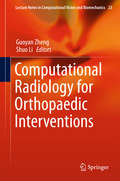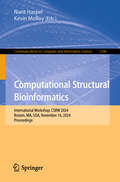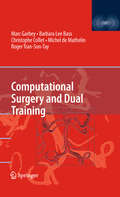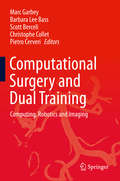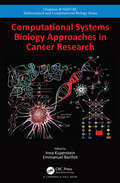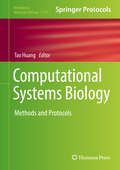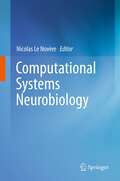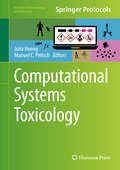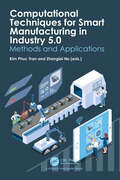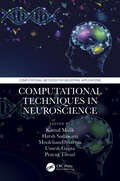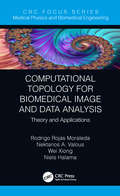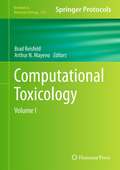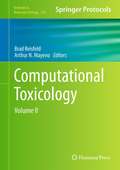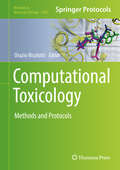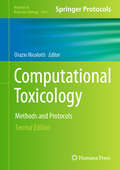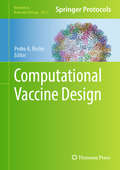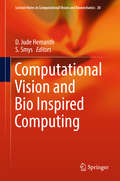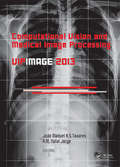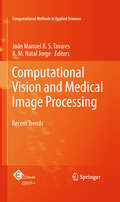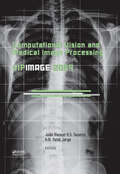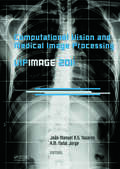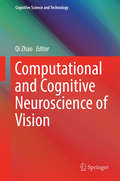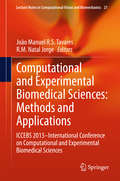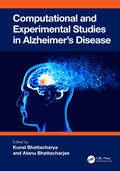- Table View
- List View
Computational Radiology for Orthopaedic Interventions (Lecture Notes in Computational Vision and Biomechanics #23)
by Guoyan Zheng Shuo LiThis book provides a cohesive overview of the current technological advances in computational radiology, and their applications in orthopaedic interventions. Contributed by the leading researchers in the field, this volume covers not only basic computational radiology techniques such as statistical shape modeling, CT/MRI segmentation, augmented reality and micro-CT image processing, but also the applications of these techniques to various orthopaedic interventional tasks. Details about following important state-of-the-art development are featured: 3D preoperative planning and patient-specific instrumentation for surgical treatment of long-bone deformities, computer assisted diagnosis and planning of periacetabular osteotomy and femoroacetabular impingement, 2D-3D reconstruction-based planning of total hip arthroplasty, image fusion for computer-assisted bone tumor surgery, intra-operative three-dimensional imaging in fracture treatment, augmented reality based orthopaedic interventions and education, medical robotics for musculoskeletal surgery, inertial sensor-based cost-effective surgical navigation, and computer assisted hip resurfacing using patient-specific instrument guides. Edited and authored by leading researchers in the field, this work is an essential reference for biomedical engineers, computer scientists and orthopaedic surgeons to develop or use computational radiology approaches for orthopaedic surgery and interventions.
Computational Structural Bioinformatics: International Workshop, CSBW 2024, Boston, MA, USA, November 16, 2024, Proceedings (Communications in Computer and Information Science #2396)
by Nurit Haspel Kevin MolloyThis book constitutes the proceedings of the Computational Structural Bioinformatics Workshop, CMSB 2024, which took place in Boston, MA, USA, on November 16, 2024. The 7 papers presented in this book were carefully reviewed and selected for inclusion in the proceedings. They deal with relevant problems in classification, modeling and analyzing protein structures and complexes.
Computational Surgery and Dual Training: Computing, Robotics And Imaging
by Christophe Collet Michel De Mathelin Marc Garbey Roger Tran-Son-Tay Barbara Lee BassThe new and emerging field of computational surgery will improve the efficiency and quality of surgery and will give patients access to very complex surgical operations that require extreme precision and minimum intrusion. In order to effectively deploy computational surgery techniques in life threatening cases such as inoperable cancer tumors that have invaded critical artery tissues or the nervous system, surgeons will have to become very familiar with computing methods, such as image analysis, augmented reality and robotics. Computational Surgery and Dual Training provides the necessary background in computer and surgical techniques that will enable computer scientists/biomedical engineers and surgeons to work together to improve interventional procedures and surgeries.
Computational Surgery and Dual Training: Computing, Robotics and Imaging
by Christophe Collet Marc Garbey Barbara Lee Bass Scott Berceli Pietro CerveriThis critical volume focuses on the use of medical imaging, medical robotics, simulation, and information technology in surgery. Part I discusses computational surgery and disease management and specifically breast conservative therapy, abdominal surgery for cancer, vascular occlusive disease and trauma medicine. Part II covers the role of image processing and visualization in surgical intervention with a focus on case studies. Part III presents the important role of robotics in image driven intervention. Part IV provides a road map for modeling, simulation and experimental data. Part V deals specifically with the importance of training in the computational surgery area.
Computational Systems Biology Approaches in Cancer Research (Chapman & Hall/CRC Computational Biology Series)
by Inna Kuperstein Emmanuel BarillotPraise for Computational Systems BiologyApproaches in Cancer Research: "Complex concepts are written clearly and with informative illustrations and useful links. The book is enjoyable to read yet provides sufficient depth to serve as a valuable resource for both students and faculty." — Trey Ideker, Professor of Medicine, UC Xan Diego, School of Medicine "This volume is attractive because it addresses important and timely topics for research and teaching on computational methods in cancer research. It covers a broad variety of approaches, exposes recent innovations in computational methods, and provides acces to source code and to dedicated interactive web sites." — Yves Moreau, Department of Electrical Engineering, SysBioSys Centre for Computational Systems Biology, University of Leuven With the availability of massive amounts of data in biology, the need for advanced computational tools and techniques is becoming increasingly important and key in understanding biology in disease and healthy states. This book focuses on computational systems biology approaches, with a particular lens on tackling one of the most challenging diseases - cancer. The book provides an important reference and teaching material in the field of computational biology in general and cancer systems biology in particular. The book presents a list of modern approaches in systems biology with application to cancer research and beyond. It is structured in a didactic form such that the idea of each approach can easily be grasped from the short text and self-explanatory figures. The coverage of topics is diverse: from pathway resources, through methods for data analysis and single data analysis to drug response predictors, classifiers and image analysis using machine learning and artificial intelligence approaches. Features Up to date using a wide range of approaches Applicationexample in each chapter Online resources with useful applications’
Computational Systems Biology: Methods And Protocols (Methods In Molecular Biology #1754)
by Tao HuangThis volume introduces the reader to the latest experimental and bioinformatics methods for DNA sequencing, RNA sequencing, cell-free tumour DNA sequencing, single cell sequencing, single-cell proteomics and metabolomics. Chapters detail advanced analysis methods, such as Genome-Wide Association Studies (GWAS), machine learning, reconstruction and analysis of gene regulatory networks and differential coexpression network analysis, and gave a practical guide for how to choose and use the right algorithm or software to handle specific high throughput data or multi-omics data. Written in the highly successful Methods in Molecular Biology series format, chapters include introductions to their respective topics, lists of the necessary materials and reagents, step-by-step, readily reproducible laboratory protocols, and tips on troubleshooting and avoiding known pitfalls.Authoritative and cutting-edge, Computational Systems Biology: Methods and Protocols aims to ensure successful results in the further study of this vital field.
Computational Systems Neurobiology
by N. Le NovèreComputational neurosciences and systems biology are among the main domains of life science research where mathematical modeling made a difference. This book introduces the many different types of computational studies one can develop to study neuronal systems. It is aimed at undergraduate students starting their research in computational neurobiology or more senior researchers who would like, or need, to move towards computational approaches. Based on their specific project, the readers would then move to one of the more specialized excellent textbooks available in the field. The first part of the book deals with molecular systems biology. Functional genomics is introduced through examples of transcriptomics and proteomics studies of neurobiological interest. Quantitative modelling of biochemical systems is presented in homogeneous compartments and using spatial descriptions. A second part deals with the various approaches to model single neuron physiology, and naturally moves to neuronal networks. A division is focused on the development of neurons and neuronal systems and the book closes on a series of methodological chapters. From the molecules to the organ, thinking at the level of systems is transforming biology and its impact on society. This book will help the reader to hop on the train directly in the tank engine.
Computational Systems Toxicology (Methods in Pharmacology and Toxicology)
by Julia Hoeng Manuel C. PeitschThis detailed volume explores key state-of-the-art computational applications that are crucial in Systems Toxicology. The recent technological developments in experimental biology and multi-omics measurements that enable Systems Biology and Systems Toxicology can only be fully leveraged by the application of a broad range of computational approaches ranging from data management to mathematical modeling. Taking this into account, chapters in this book cover data management and processing, data analysis, biological network building and analysis, as well as the application of computational methods to toxicological assessment. Written for the Methods in Pharmacology and Toxicology series, Computational Systems Toxicology includes the kind of key practical advice that will aid readers in furthering our knowledge of toxic substances and reactions to them.
Computational Techniques for Smart Manufacturing in Industry 5.0: Methods and Applications
by Zhenglei HeWe are witnessing rapid development in computational technologies and its applications in industry, leading to the 5th industrial revolution. Industry 5.0 is characterized by the synergies between machines and humans, with an aim to add value to production by creating personalized products able to meet customers' requirements. These intelligent manufacturing systems have been sought in various sectors (e.g. automobiles, power supplying, chemistry) to realize data-driven innovations for delivering highly customizable products and services faster, cheaper, better, and greener.This book presents recent advancements in research, new methods and techniques, and applications of advanced computational technologies in intelligent manufacturing for modeling, simulating, optimization, decision making, and other typical issues in manufacturing processes. It stimulates the scientific exchange of ideas and experiences in the field of intelligent manufacturing applications. Researchers and practitioners alike will benefit from this book to enhance their understanding of Industry 5.0, which focuses on combining human creativity and craftsmanship with the speed, productivity, and consistency of AI systems. Real-world case studies in various fields and practical applications are provided in each chapter.
Computational Techniques in Neuroscience (Computational Methods for Industrial Applications)
by Umesh Gupta Moolchand Sharma Prayag Tiwari Kamal Malik Harsh SadawartiThe text discusses the techniques of deep learning and machine learning in the field of neuroscience, engineering approaches to study the brain structure and dynamics, convolutional networks for fast, energy-efficient neuromorphic computing, and reinforcement learning in feedback control. It showcases case studies in neural data analysis. Features: Focuses on neuron modeling, development, and direction of neural circuits to explain perception, behavior, and biologically inspired intelligent agents for decision making Showcases important aspects such as human behavior prediction using smart technologies and understanding the modeling of nervous systems Discusses nature-inspired algorithms such as swarm intelligence, ant colony optimization, and multi-agent systems Presents information-theoretic, control-theoretic, and decision-theoretic approaches in neuroscience. Includes case studies in functional magnetic resonance imaging (fMRI) and neural data analysis This reference text addresses different applications of computational neuro-sciences using artificial intelligence, deep learning, and other machine learning techniques to fine-tune the models, thereby solving the real-life problems prominently. It will further discuss important topics such as neural rehabili-tation, brain-computer interfacing, neural control, neural system analysis, and neurobiologically inspired self-monitoring systems. It will serve as an ideal reference text for graduate students and academic researchers in the fields of electrical engineering, electronics and communication engineering, computer engineering, information technology, and biomedical engineering.
Computational Topology for Biomedical Image and Data Analysis: Theory and Applications (Focus Series in Medical Physics and Biomedical Engineering)
by Wei Xiong Rodrigo Rojas Moraleda Nektarios A. Valous Niels HalamaThis book provides an accessible yet rigorous introduction to topology and homology focused on the simplicial space. It presents a compact pipeline from the foundations of topology to biomedical applications. It will be of interest to medical physicists, computer scientists, and engineers, as well as undergraduate and graduate students interested in this topic. Features: Presents a practical guide to algebraic topology as well as persistence homology Contains application examples in the field of biomedicine, including the analysis of histological images and point cloud data
Computational Toxicology, Volume I: Volume I (Methods in Molecular Biology #929)
by Arthur N. Mayeno Brad ReisfeldRapid advances in computer science, biology, chemistry, and other disciplines are enabling powerful new computational tools and models for toxicology and pharmacology. These computational tools hold tremendous promise for advancing science, from streamlining drug efficacy and safety testing, to increasing the efficiency and effectiveness of risk assessment for environmental chemicals. Computational Toxicology provides biomedical and quantitative scientists with essential background, context, examples, useful tips, and an overview of current developments in the field. Divided into four sections, Volume I covers a wide array of methodologies and topics. Opening with an introduction to the field of computational toxicology and its current and potential applications, the volume continues with 'best practices' in mathematical and computational modeling, followed by chemoinformatics and the use of computational techniques and databases to predict chemical properties and toxicity, as well as an overview of molecular dynamics. The final section is a compilation of the key elements and main approaches used in pharmacokinetic and pharmacodynamic modeling, including the modeling of absorption, compartment and non-compartmental modeling, physiologically based pharmacokinetic modeling, interspecies extrapolation, and population effects. Written in the successful Methods in Molecular BiologyTM series format where possible, chapters include introductions to their respective topics, lists of the materials and software tools used, methods, and notes on troubleshooting.<P><P> Authoritative and easily accessible, Computational Toxicology will allow motivated readers to participate in this exciting field and undertake a diversity of realistic problems of interest.
Computational Toxicology, Volume II: Volume II (Methods in Molecular Biology #930)
by Arthur N. Mayeno Brad ReisfeldRapid advances in computer science, biology, chemistry, and other disciplines are enabling powerful new computational tools and models for toxicology and pharmacology. These computational tools hold tremendous promise for advancing applied and basic science, from streamlining drug efficacy and safety testing, to increasing the efficiency and effectiveness of risk assessment for environmental chemicals. Computational Toxicology was conceived to provide both experienced and new biomedical and quantitative scientists with essential background, context, examples, useful tips, and an overview of current developments in the field. This two-volume set serves as a resource to help introduce and guide readers in the development and practice of these tools to solve problems and perform analyses in this area.<P><P> Divided into six sections, Volume II covers a wide array of methodologies and topics. The volume begins by exploring the critical area of predicting toxicological and pharmacological endpoints, as well as approaches used in the analysis of gene, signaling, regulatory, and metabolic networks. The next section focuses on diagnostic and prognostic molecular indicators (biomarkers), followed by the application of modeling in the context of government regulatory agencies. Systems toxicology approaches are also introduced. The volume closes with primers and background on some of the key mathematical and statistical methods covered earlier, as well as a list of other resources. Written in a format consistent with the successful Methods in Molecular Biology™ series where possible, chapters include introductions to their respective topics, lists of the necessary materials and software tools used, methods, and notes on troubleshooting and avoiding known pitfalls.<P> Authoritative and easily accessible, Computational Toxicology will allow motivated readers to participate in this exciting field and undertake a diversity of realistic problems of interest.
Computational Toxicology: Methods and Protocols (Methods in Molecular Biology #1800)
by Orazio NicolottiThis volume explores techniques that are currently used to understand solid target-specific models in computational toxicology. The chapters are divided into four sections and discuss topics such as molecular descriptors, QSAR and read-across; molecular and data modeling techniques to comply with both scientific and regulatory sides; computational toxicology in drug discovery; and strategies on how to predict various human-health toxicology endpoints. Written in the highly successful Methods in Molecular Biology series format, chapters include introductions to their respective topics, lists of the methods and software tools used, step-by-step, readily reproducible computational protocols, and tips on troubleshooting and avoiding known pitfalls.Comprehensive and cutting-edge, Computational Toxicology: Methods and Protocols is a valuable resource for researchers who are interested in learning more about this expanding field.
Computational Toxicology: Methods and Protocols (Methods in Molecular Biology #2834)
by Orazio NicolottiThis second eidtion explores new and updated techniques used to understand solid target-specific models in computational toxicology. Chapters are divided into four sections, detailing molecular descriptors, QSAR and read-across, molecular and data modeling techniques, computational toxicology in drug discovery, molecular fingerprints, AI techniques, and safe drug design. Written in the highly successful Methods in Molecular Biology series format, chapters include introductions to their respective topics, lists of the necessary materials and reagents, step-by-step, readily reproducible laboratory protocols, and key tips on troubleshooting and avoiding known pitfalls. Authoritative and cutting-edge, Computational Toxicology: Methods and Protocols, Second Editon aims to ensure successful results in the further study of this vital field.
Computational Vaccine Design (Methods in Molecular Biology #2673)
by Pedro A. RecheThis volume explores computational vaccine design and the technologies that support it. Chapters have been divided into four parts detailing immunonics and system immunology, databases, prediction of antigenicity and immunogenicity, and computational vaccinology. Written in the format of the highly successful Methods in Molecular Biology series, each chapter includes an introduction to the topic, lists necessary materials and reagents, includes tips on troubleshooting and known pitfalls, and step-by-step, readily reproducible protocols. Authoritative and cutting-edge, Computational Vaccine Design: Methods and Protocols aims to reflect on the rigorous and imaginative use of computational technologies to help catalyze future efforts and to improve global public health through the development of a broad range of novel vaccines.
Computational Vision and Bio Inspired Computing
by D. Jude Hemanth S. SmysThis is the proceedings of the International Conference On Computational Vision and Bio Inspired Computing (ICCVBIC 2017) held at RVS Technical Campus, September 21-22, 2017. It includes papers on state of the art innovations in bio-inspired computing applications, where new algorithms and results are produced and described. Additionally, this volume addresses evolutionary computation paradigms, artificial neural networks and biocomputing. It focuses mainly on research based on visual interference on the basis of biological images. Computation of data sources also plays a major role in routine day-to-day life for the purposes such as video transmission, wireless applications, fingerprint recognition and processing, big data intelligence, automation, human centric recognition systems. With the advantage of processing bio-inspired computations, a variety of computational paradigms can be processed. Finally, this book also treats the formation of neural networks by enabling local connectivity within it with the aid of vision sensing elements. The work also provides potential directions for future research.
Computational Vision and Medical Image Processing IV: VIPIMAGE 2013
by João Manuel R.S. Tavares R.M. Natal JorgeComputational Vision and Medical Image Processing. VIPIMAGE 2013 contains invited lectures and full papers presented at VIPIMAGE 2013 - IV ECCOMAS Thematic Conference on Computational Vision and Medical Image Processing (Funchal, Madeira Island, Portugal, 14-16 October 2013). International contributions from 16 countries provide a comprehensive cov
Computational Vision and Medical Image Processing V: Proceedings of the 5th Eccomas Thematic Conference on Computational Vision and Medical Image Processing (VipIMAGE 2015, Tenerife, Spain, October 19-21, 2015)
by João Manuel R.S. Tavares R.M. Natal JorgeVipIMAGE 2015 contains invited lectures and full papers presented at VIPIMAGE 2015 - V ECCOMAS Thematic Conference on Computational Vision and Medical Image Processing (Tenerife, Canary Islands, Spain, 19-21 October, 2015). International contributions from 19 countries provide a comprehensive coverage of the current state-of-the-art in the fields o
Computational Vision and Medical Image Processing: Recent Trends (Computational Methods in Applied Sciences #19)
by Joao Tavares R. M. JorgeThis book contains extended versions of papers presented at the international Conference VIPIMAGE 2009 - ECCOMAS Thematic Conference on Computational Vision and Medical Image, that was held at Faculdade de Engenharia da Universidade do Porto, Portugal, from 14th to 16th of October 2009. This conference was the second ECCOMAS thematic conference on computational vision and medical image processing. It covered topics related to image processing and analysis, medical imaging and computational modelling and simulation, considering their multidisciplinary nature. The book collects the state-of-the-art research, methods and new trends on the subject of computational vision and medical image processing contributing to the development of these knowledge areas.
Computational Vision and Medical Image Processing: VipIMAGE 2009
by João Manuel R.S. Tavares & R.M. Natal JorgeComputational Vision and Medical Image Processing, VIPIMAGE 2009 contains the full papers presented at VIPIMAGE 2009 - Second ECCOMAS Thematic Conference on Computational Vision and Medical Image Processing, held in Porto, Portugal, on 14-16 October 2009. International contributions from twenty countries provide a comprehensive coverage of the curr
Computational Vision and Medical Image Processing: VipIMAGE 2011
by João Manuel R.S. Tavares R.M. Natal JorgeThis book contains invited lecturers and full papers presented at VIPIMAGE 2011 - III ECCOMAS Thematic Conference on Computational Vision and Medical Image Processing (Olh Algarve, Portugal, 12-14 October 2011). International contributions from 16 countries provide a comprehensive coverage of the current state-of-the-art in: Image Processing
Computational and Cognitive Neuroscience of Vision (Cognitive Science and Technology)
by Qi ZhaoDespite a plethora of scientific literature devoted to vision research and the trend toward integrative research, the borders between disciplines remain a practical difficulty. To address this problem, this book provides a systematic and comprehensive overview of vision from various perspectives, ranging from neuroscience to cognition, and from computational principles to engineering developments. It is written by leading international researchers in the field, with an emphasis on linking multiple disciplines and the impact such synergy can lead to in terms of both scientific breakthroughs and technology innovations. It is aimed at active researchers and interested scientists and engineers in related fields.
Computational and Experimental Biomedical Sciences: ICCEBS 2013 -- International Conference on Computational and Experimental Biomedical Sciences (Lecture Notes in Computational Vision and Biomechanics #21)
by João Manuel R. S. Tavares R. M. Natal JorgeThis book contains the full papers presented at ICCEBS 2013 - the 1st International Conference on Computational and Experimental Biomedical Sciences, which was organized in Azores, in October 2013. The included papers present and discuss new trends in those fields, using several methods and techniques, including active shape models, constitutive models, isogeometric elements, genetic algorithms, level sets, material models, neural networks, optimization and the finite element method, in order to address more efficiently different and timely applications involving biofluids, computer simulation, computational biomechanics, image based diagnosis, image processing and analysis, image segmentation, image registration, scaffolds, simulation and surgical planning. The main audience for this book consists of researchers, Ph. D students and graduate students with multidisciplinary interests related to the areas of artificial intelligence, bioengineering, biology, biomechanics, computational fluid dynamics, computational mechanics, computational vision, histology, human motion, imagiology, applied mathematics, medical image, medicine, orthopaedics, rehabilitation, speech production and tissue engineering.
Computational and Experimental Studies in Alzheimer's Disease
by Atanu Bhattacharjee Kunal BhattacharyaThis reference book compiles the recent advances in computational and experimental modelling to screen and manage Alzheimer’s disease. It covers basic etiopathology and various in vitro and in vivo strategies of disease intervention. The book discusses how computer-aided drug design approaches reduce costs and increase biological test efficiency. It reviews the screening for anti-Alzheimer drugs and biomarker analysis of disease inhibitors. The book also explores mechanistic aspects of neurodegeneration and the use of natural products as therapeutics for Alzheimer’s disease.Key features: Elaborates on the computational modelling of protein target inhibitors as anti-Alzheimer’s agents Explains the role of phytomolecules and natural products in Alzheimer’s therapy Reviews preclinical ways to assess drugs focusing on Alzheimer’s disease Covers biomarker analysis for Alzheimer’s disease Discusses the onset and progression of Alzheimer’s disease The book is meant for professionals, researchers, and students of neuroscience, psychology, and computational neurosciences.
